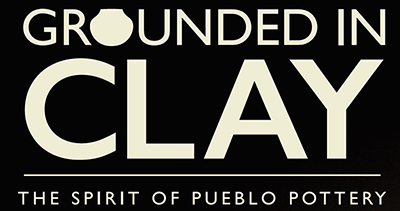Nathan Youngblood
Santa Clara
Curator Nathan Youngblood (Santa Clara) is a potter, designer, and master apprentice.
Nathan chose the following for the Grounded in Clay exhibit:
Rainbow Bands
This interesting and unusual water jar with three defined rainbow bands was created by my great-grandmother Serafina Gutierrez Tafoya, probably in the period 1890–1900. Water jars were used daily to transport water from the stream in Santa Clara Pueblo and to store it in the home. My grandmother Margaret Tafoya told me that they had several water jars in their home when she was growing up: two to hold water during the day, and two for evening storage.
Rainbow bands were often built into water jars as a prayer to protect the water and to arrest evaporation. Serafina had to be very careful in shaping this piece because the wall of the jar is relatively thin. Thin-walled vessels allow very little leeway to correct the shaping of a piece by scraping or sanding. Creating such a jar must have taken great faith and courage. The fact that I have seen only three pieces with multiple rainbow bands attests to the great difficulty in successfully making, burnishing, and firing these vessels.
Holding this piece, I realized that I would be able to pour water from it without the jar slipping from my hands. My fingers fitted easily around the rainbow bands.
I have examined this jar carefully and have determined that it was actually used, unlike more modern pottery made to sell to traders and tourists in the early 1900s. Looking inside, I saw small-scale residue that water had left from usage. There is an area at the inside bottom of the jar where either a seepage crack or thin section had developed. Hot pine pitch had been applied to repair this problem. Examining the outside bottom of the jar, I located minor spalling, a condition known to occur when water has saturated the walls of pottery fired at a low temperature. Because of this spalling and the uniqueness of the multiple rainbow bands, I believe that this jar was made to be used either on special occasions or for ceremonial events, or both.
As to dating this jar, we know that this piece was acquired in 1927, purchased from the Spanish and Indian Trading Company through the Indian Arts Fund. I believe that this jar was made before 1925. Its wall is thin compared to later work, and the composition of the clay mirrors that of clay used before 1925. We know that a landslide in the late 1920s covered the source of this clay in Santa Clara Pueblo. Potters had to move to a different area to find a clay vein that was suitable for making pottery. The new source was not as strong as the previous clay vein. This contributed to thicker-walled work and allowed the deeply incised carving of designs, beginning in the late 1920s.
As I held the jar and explored it, I wondered what my great-grandmother was thinking and experiencing in her life as she created this incredible piece. Today when we visit the pottery from her life’s work, we marvel at her skill, conceptual designs, engineering, and execution. I am humbled by her creations and her life. I am so very proud to be her great-grandson and part of a remarkably talented lineage.

